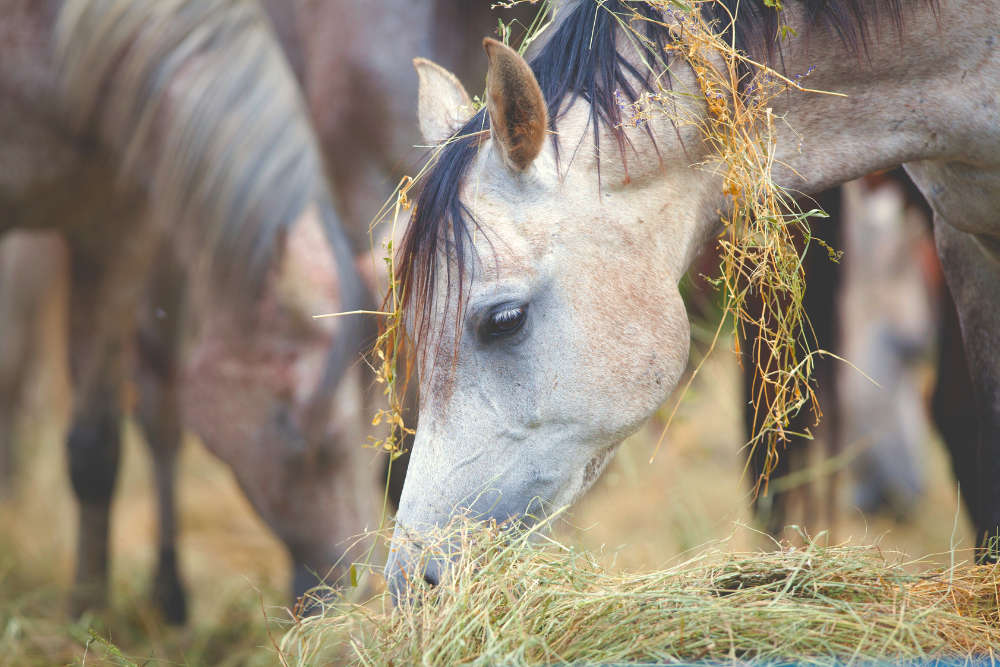Forage Buying Guide: Part 1

Written by Briony Witherow MSc RNutr. FHEA
This time of year, hay and haylage making is in full flow and while for those of us with horses out at pasture this time of year it may not be top of our list of considerations, applying some thought at this point can pay dividends. Part 1 explores what to buy and part 2 investigates when and how to buy.
Type of forage
There are no hard and fast rules that can be applied when it comes to predicting the suitability of a hay as compared to a haylage – for a detailed look at the differences between these two forage types see What are the differences between hay and haylage?
One of the key considerations here is storage. While haylage can be stored outside, hay requires undercover storage (with the exception of wrapped hay). Storage capacity is therefore likely to be a leading factor in your decision between hay and haylage.
Shelf-life is also a consideration. When open, haylage may only last 2-7 days (depending on the time of year) and therefore may lead to high levels of waste with fewer horses. While smaller bales of haylage are available, this is often less economic. Hay on the other hand (when appropriately stored), can still be fed after several years. In this time however, the nutrient level will decline, and dust content may increase (due to leaf shatter). Soaking or steaming is then advisable, although very dusty or visibly mouldy hay should never be fed.
In addition to the choice between hay or haylage, different grass species are available, these can be broadly categorised as either meadow or seed hay/haylage. A meadow hay/haylage generally refers to a forage that is harvested from permanent pasture and usually contains a variety of grass species. While a seed hay/haylage refers to grass that has been specifically sown for hay/haylage production, typically of one or two species (most commonly ryegrass and timothy).
While there are no absolutes when it comes to predicting suitability, a seed hay or haylage can provide a more consistent end product. In this way, seed forages can be more appropriate for good doer types or those with restricted forage access, with the choice in variety of grass often making it easier to select a product tailored to your horse’s requirements. Timothy and ryegrass are the most common species available (single grass species products or a combination). Timothy grasses tend to be lower in overall energy/calories when compared to ryegrass forages, making timothy-based forages often more suitable for the better doer and leisure horse.
Bale Size
Forage is baled for the simple reason of convenience and ease of handling for both transport and storage. However, the size and shape of the bale can also be a deal breaker when considering handling the forage on your yard. Bales come in a variety of bale sizes, ranging from small conventional bales (~20kg in weight) to Hesston bales (anywhere from 600kg in weight), and much in between, an appropriate choice bearing in mind convenience and safety can generally be sought. It is worth noting that the weight of bales is very variable and will be dependent on moisture content and baling density.
Suitability for horses
Buying from a supplier who produces forage specifically for horses means they tend to be more aware of the requirements of horse and owner. I am sure I am not alone in having found various foreign objects appear in the bottom of a net/feeder ranging from brush ends to plastic bags. While some of these are unavoidable for even the most conscientious of producers, limiting our horse’s exposure to this and the potential for poisonous plants is a clear priority. Forage producers that harvest and market forage specifically for horses typically should be more aware of poisonous plants such as ragwort and take precautions to reduce the risk of these plants ending up in their products practices to reduce this risk include regular field walking, using wide field margins and reseeding where necessary. While this care and attention often comes at a premium, for those wanting quality and consistency, this is often a good option.
Consistency is another factor essential for our horses. While a producer may not be able to guarantee supply from the same field for every order, a producer that grows seed hay/haylage should be able to supply a product of similar grass species and maturity (cut) to help provide consistency. This consistency will be potentially easier to achieve, if you have greater storage capacity allowing you to buy in bulk, increasing the chance of supply being from the same batch.
